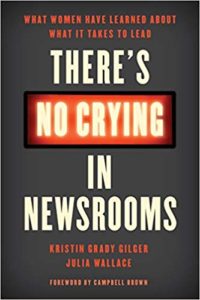Book captures ‘what it takes for women to lead, not just in the news business but in any business’
Reviewed by Carolyn Schurr Levin
 The co-editors-in-chief of the college newspaper that I advise are women. Last year’s editor-in-chief was a woman. In fact, in my nine years as the paper’s faculty adviser, the vast majority of the editors have been women. They have been talented and confident and unafraid to use the skills they are honing on campus at their summer internships or, after they graduate, in the workplace. Yet, are college newspapers, which, according to anecdotal evidence, are often largely staffed and led by female students, reflective of the workplace these students will enter upon graduation? What awaits these passionate young female journalists? Can they rise to the same level that they have achieved on campus, where running the student newspaper makes them campus leaders?
The co-editors-in-chief of the college newspaper that I advise are women. Last year’s editor-in-chief was a woman. In fact, in my nine years as the paper’s faculty adviser, the vast majority of the editors have been women. They have been talented and confident and unafraid to use the skills they are honing on campus at their summer internships or, after they graduate, in the workplace. Yet, are college newspapers, which, according to anecdotal evidence, are often largely staffed and led by female students, reflective of the workplace these students will enter upon graduation? What awaits these passionate young female journalists? Can they rise to the same level that they have achieved on campus, where running the student newspaper makes them campus leaders?
Kristin Gilger, Senior Associate Dean and Reynolds Professor in Business Journalism in the Walter Cronkite School of Journalism and Mass Communication at Arizona State University, and her colleague, Julia Wallace, Frank Russell Chair in the Business of Journalism at ASU, explore the answers to these questions in their new book, “There’s No Crying in Newsrooms,” published by Rowman & Littlefield in July 2019. Through the stories and experiences of female newsroom leaders, Gilger and Wallace examine “What Women Have Learned about What It Takes to Lead.”
Campbell Brown, former NBC news correspondent and CNN prime-time host who is now the head of global news partnerships at Facebook, aptly summarizes the valuable lessons of this book in her Foreword. “Every woman I know in the news business has at least one story to tell about another woman who helped show her the way,” Brown writes. “Over the past four decades, scores of women have walked into newsrooms only to find they were unwanted and unsupported and, still, they worked their way to the top,” she continues. Gilger and Wallace’s book “captures the voices of these funny, strong, and brash women who learned – often the hard way – exactly what it takes for women to lead, not just in the news business but in any business,” Brown says.
“There’s No Crying in Newsrooms” is different from other books that have examined women in the media. “Most of the other books about women in media either focus on one or several successful, well-known women and basically profile them, or they are history books,” Gilger said. “Ours tells the history of women in news over the past 40 or so years through strong narrative story-telling. We wanted to include lots of voices.”
Gilger and Wallace culled the book’s stories from interviews they conducted in 2017 and 2018 with more than 100 people, most of them women, including well-known journalists such as Christiane Amanpour, Gretchen Carlson, Jill Abramson, and Nina Totenberg, and many others who are not as well known, but all of whom changed American journalism over the past 40 years. Not only did “nearly every single one of the women leaders” contacted agree to speak, “but they couldn’t wait to talk to us,” the authors write. “And once they started talking, it was difficult to get them to stop.”
Why this book and why now? First, the numbers for women in journalism appear to be slipping. At newspapers, the authors write, women seemed to hit a peak in the late 1990s and early 2000s. Women aren’t doing much better in television and radio. According to a 2018 Radio Television Digital News Association Report, women made up just 22 percent of general managers at U.S. radio stations, 34 percent of TV news directors, and fewer than 20 percent of general managers. And, the #MeToo movement has “vividly illustrated” that women still contend with sexual harassment and sexual predators in the media workplace, which toppled Matt Lauer, Charlie Rose, Roger Ailes and too many others. Because Gilger and Wallace “love newsrooms” and “care about what happens to them,” and because they teach journalism “in a school filled with smart, ambitious young women who inspire” them, they want to help their own students – and others – navigate today’s news business.
The stories in “There’s No Crying in Newsrooms” are personal and enlightening, offering insights into newsroom and digital media culture while detailing the challenges, day-to-day experiences and just plain hard work of women leaders. Although the obstacles these women faced, and continue to face, may not differ all that much from those faced by women in a myriad of other fields, the authors point out that the competitive, 24 hour a day nature of journalism “makes it an especially challenging profession for women who face almost daily choices between the personal and the professional.”
What I found most helpful about the book was the professorial advice that Gilger and Wallace offer at the end of each chapter, culled from the wisdom of the women leaders they interviewed. “Embrace Your Scarlett and Your Melanie,” they write, urging students that they “still have room to develop their own distinctive and effective styles. Other advice includes: “Confidence Counts.” “Give Others Credit.” “Watch and Learn.” In a tip called “About the Crying,” they acknowledge that they have both been known to warn young women not to cry in newsrooms, but that perhaps their advice needs to be tempered. “Too often, we tolerate screamers but not criers,” they write, “and maybe it would be better if that ratio was flipped.” Gilger suggested that the lessons from the narratives at the end of each chapter “will be useful for women, not just in news organizations but any field.”
And lest you think that this is a book only for women, the authors indicated that “There’s No Crying in Newsrooms” will have broad appeal. “We think the book will be of interest to any woman who aspires to leadership in any male-dominated company, but we expect it will especially resonate with women in media,” Gilger said. “At journalism schools across the country, women make up two-thirds to three-quarters of enrollments, and we are especially hopeful that the book will be a useful guide for them.” By capturing what women have learned about what it takes for a woman to lead, they hope to “pass that knowledge on to the next generation of women leaders” and at the same time “appeal to men, many of whom are interested and open to understanding the experiences of women, and who need to be part of this conversation.”
When I finished reading “There’s No Crying in Newsrooms,” I had a long list of advice that I wanted to frame and hang in the student newspaper office on campus for my students. Although it is hard to pick just one piece of advice to sum up the impactful nature of this book for journalism and media students, NBC News senior vice president Rashida Jones’ quote sticks with me: “Do the work; prove them wrong.”

Carolyn Schurr Levin has been the faculty adviser for the student newspaper at Long Island University since 2010. She has taught at Long Island University, Stony Brook University, Baruch College, and Pace University. Before teaching full time, she was the Vice President and General Counsel of Newsday and the Vice President and General Counsel of Ziff Davis Media.
